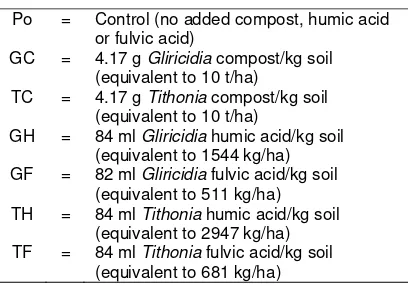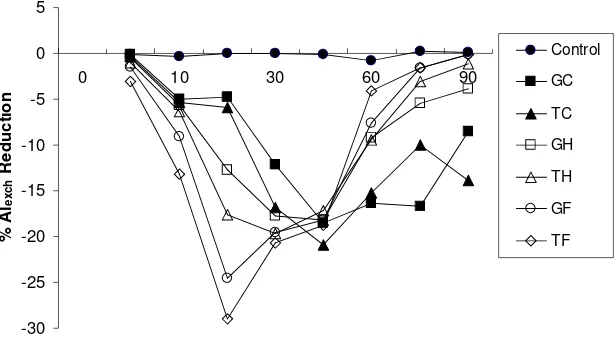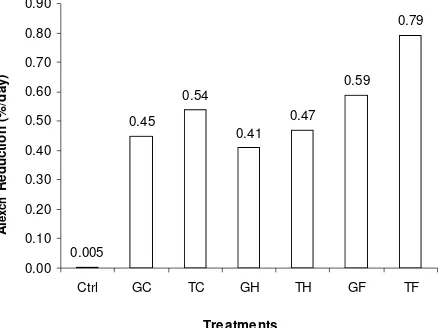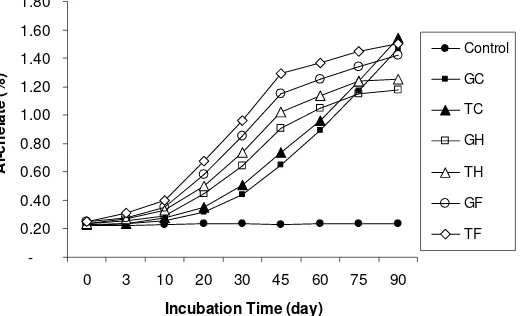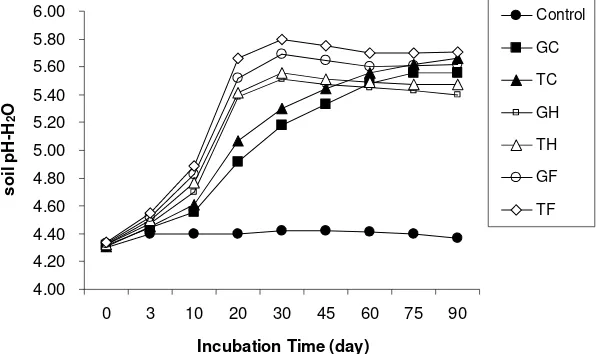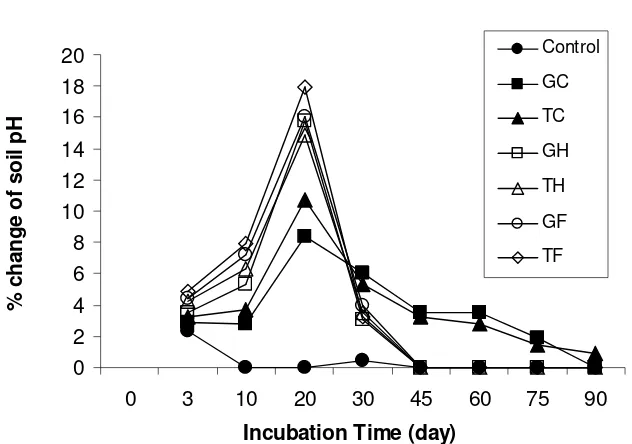216
AGRIVITA VOLUME 32 No. 3 OCTOBER-2010 ISSN : 0126-0537
HUMIC AND FULVIC ACIDS OF GLIRICIDIA AND TITHONIA COMPOSTS
FOR ALUMINIUM DETOXIFICATION IN AN ULTISOL
Imam Wahyudi 1), Eko Handayanto2*), Syekhfani2) and Wani Hadi Utomo2)
1)Faculty of Agriculture, Tadulako University
Jl. Soekarno-Hatta Km 9, Kampus Bumi Tadulako Palu Central Sulawesi Indonesia
2)
Faculty of Agriculture, Brawijaya University Jl. Veteran Malang 65145 East Java Indonesia *)
Corresponding author Phone : +62-341-553623 E-mail: ehn-fp@ub.ac.id
Received: August 2, 2009/ Accepted : December 16, 2009
ABSTRACT
A laboratory experiment was conducted to elucidate roles of Gliricidia sepium and Tithonia diversifolia composts and their extracted humic and fulvic acids on aluminum concentration in an Ultisol. Those composts and humic and fulvic acids extracted from them mixed with soil were arranged in a complete randomized design with three replicates, and incubated for 90 days. Al concentration and pH of the soil were measured at 0, 3, 10, 20, 30, 45, 60, 75 and 90 days after incubation. Results of the study showed that the highest decrease in exchangeable Al concentration (90.5%) was observed for Tithonia fulvic acid treatment during 90 days, followed by Tithonia compost (88.4%), Gliricidia fulvic acid (82.3%), Gliricida compost (82.2%), Tithonia humic acid (75.66%), and Gliricidia humic acid (73.46%) treatments, whereas control only decreased exchangeable Al concentration by 0.9%. The rate of change in exchangeable Al concentration was fast for the first 45 days, but it then slowed down for the second 45 days (45-90 days). This was particularly observed with organic acid treatments, whereas compost treatment still showed a subsequent decrease. Patterns of Al chelate and pH were very similar to that of exchangeable Al. It was thus concluded that roles of humic and fulvic acids in reducing exchangeable Al was only short term, whereas compost played roles in the long term.
Keywords: Ultisol, aluminium, humic acid, fulvic acid, Gliricidia sepium, Tithonia diversifolia
INTRODUCTION
Ultisol generally can be found as agri-cultural land distributed in Sumatera, Kalimantan, Sulawesi, Irian Jaya and a small area in Java especially in West Java. One problem of Ultisol for agriculture cultivation is high solubility of Al related to soil acidity levels (Mokolobate and Haynes, 2002). The high solubility of Al causes P nutrient in soil bind to become Al-P which is not soluble so that it can reduce P available for plants (Bates and Lynch,
Ultisol generally can be found as agri-cultural land distributed in Sumatera, Kalimantan, Sulawesi, Irian Jaya and a small area in Java especially in West Java. One problem of Ultisol for agriculture cultivation is high solubility of Al related to soil acidity levels (Mokolobate and Haynes, 2002). The high solubility of Al causes P nutrient in soil bind to become Al-P which is not soluble so that it can reduce P available for plants (Bates and Lynch, 2001).
The effort usually conducted to overcome the problem of soil acidity and Al toxicity in Ultisol is liming. However, the application of high rates of lime continuously can decrease the availability of P and Mn (Shamshuddin et al., 2004). Another alternative that can be done to overcome the problem of acid mineral soils containing high Al is the application of organic matter (Zaharah et al., 1999). Organic acids present in organic matter or produced during their decomposition process can react with Al to form organo-Al complexes or Alchelate (Kalbitz et al., 2000). These complexes
can reduce aluminium solubility to certain levels that will not hinder plant growth (Agbenin, 2003)
It is widely known that organic matter is very useful for improving soil fertility, soil physical properties and ion exchange capacity.
Imam Wahyudi et al.: Humic and Fulvic Acids of Gliricidia and Tithonia Composts………...
However, large amounts of organic matter are needed to maintain and improve soil organic matter content for positive change in these properties. Such large amounts are usually beyond the reach of upland farmers. The relationship between organic matter application and nutrient release, especially nitrogen, has been enormously studied, but studies on the effects of organic matter application on improving phosphorus availability in Ultisol are relatively few.
Besides the release nutrients, other short term beneficial effects of organic matter application have not been drawn to the attention of the users. Currently, very little information is available on these practical influences. In Ultisol, an increase in soil pH and the reduction of soil Al concentrations are very important at establishment to guarantee good germination and emergence after sowing. Organic acids present in the organic matter or produced during their decomposition have been shown to interact strongly with phosphorus adsorption as they compete for the same site (Brinick and Lal, 2005). This increases phosphorus availability, with a consequent soil property change that also contributes to the improvement in crop production. Therefore, when organic matter management is considered in the context of shortage, both short-term and long-term benefits of organic matter amendment on beneficial changes other than nutrient release need to be taken into account.
Considering the variable amount and quality of organic matters, selection of organic matter needs to be considered are their availability in the field, their potential use for organic fertilizers as well as their common use by the majority of farmers. Amongst various sources of organic matter, prunings of Gliricidia sepium and Tithonia diversifolia are commonly used for improving soil productivity. Gliricidia sepium is a legume tree that can easily be found as living hedges, shelter plants and shade plants in rural areas throughout Indonesia. This tree is also commonly used by villagers as firewood (pruning of branch and twig) and the leaves as livestock feed. Tithonia diversifolia is a shrub type of vegetation that can also easily be found in rural areas. Pruning of those two organic matter sources have potential for supplying nitrogen and phosphorus. They also contain substantial amounts of humic and fulvic acids
that can reduce soil aluminium toxicity. Supriyadi (2003) reported that the application of Tithonia diversifolia prunings as organic matter in Andisol can increase Alchelate from 1.30% to 1.49%
during 30 days of incubation. Minardi et al. (2007) reported that application of Gliricidia sepium prunings in an Andisol reduced Alo by
29.85% which in turn released phosphate into the soil solution.
The aim of the research was to judge the role of organic matter addition in decreasing aluminium toxicity and phosphorus availability of an Ultisol.
MATERIALS AND METHODS
The research was a laboratory incubation experiment. The experiment, soil analysis and organic matter analysis were carried out at Soil Chemical Laboratory of the Faculty of Agriculture, Brawijaya University. All activities were conducted from July 2007 until December 2007.
Topsoil of an Ultisol collected from Kentrong Village of Cipanas Distric, Lebak Regency, Banten Province was used for this study. The soil has the following characteristics: pH 4.3, 392.45 mg total P/kg soil, 5.79 mg available P/kg soil, 49.09% Al saturation, 11.85 cmolc exchangeable Al/kg soil, 4.45 cmolc
exchangeable H/kg soil, 1.998% organic C, 0.20% total N, and C/N ratio of 9.99.
Prunings of Gliricidia sepium and Tithonia diversifolia were collected from Jatikerto Village of Malang. Prior to application, the prunings were air dried and composted using Trichoderma sp. decomposer for around 30 days. Compost produced was then analyzed for organic-C, total N, total P, humic acid and fulvic acid content. Humic and fulvic acids from the compost were extracted using 0,01 N NaOH. Chemical composition of composted Gliricidia sepium and Tithonia diversifolia prunings is presented in Table 1.
218
Imam Wahyudi et al.: Humic and Fulvic Acids of Gliricidia and Tithonia Composts………...
from the compost. The mixture was then placed in a plastic bag and incubated for 90 days. During incubation, soil moisture content was kept at field capacity by regularly adding distilled water. Analysis of soil pH, exchangeable Al and Al chelate were carried out at 0, 3, 10, 20, 30, 45, 60, 75, and 90 days. Statistical analysis was performed at significant levels of 5% and 1%. Differences between treatments were tested using Duncan Multiple Range Test (DMRT). Correlation and regression analysis were performed to judge the relationship between measured parameters.
Table 1. Chemical Composition of Gliricidia and Tithonia Composts
Table 2. Treatments of Incubation Experiment Po = Control (no added compost, humic acid
or fulvic acid)
(equivalent to 2947 kg/ha) TF = 84 ml Tithonia fulvic acid/kg soil
(equivalent to 681 kg/ha)
RESULTS AND DISCUSSION
Change of Exchangeable Al (Alexch) Concen-tration
Application of Gliricidia and Tithonia composts as well humic and fulvic acids extracted from the composts significantly (p < 0.01) affected concentration of Alexch. Humic acid
and fulvic acid derived from Gliricidia and Tithonia composts (GH, TH, GF, and TF treatments) reduced concentration of Alexch faster
than that of Gliricidia and Tithonia composts (GC and TC treatments). Alexch concentration
decreased sharply at 10 to 45 days through application of GH, TH, GF, and TF (Figure 1). For GC and TC treatments, the sharp decrease of Alexch concentration occurred at 20 to 90 days
(Figure 1).
strongly correlated with Gliricidia humic acid (GH), Tithonia humic acid (TH), Gliricidia fulvic acid (GF) and Tithonia fulvic acid (TF) with r values of 0.994, 0.994, 0.995, and 0.995 respectively. This indicated that fulvic acid posed stronger affinity than humic acid in reducing Alexch concentration.
Considering the pattern of Alexch reduction
(Figure 2), it can be seen that the reduction of aluminium concentration at all treatments was relatively fast for the first 45 days (0-45 days). The reduction of Alexch concentration due to GF
and TF treatments reached maximum at day 20, i.e. -24.56% for GF and -28.95% for TF (Figure maximum reduction of Alexch concentration
reached by the treatments only occurred at 45 days by -18.57% (GC) and -20.93% (TC).
Cumulatively, all treatments resulted in more than 70% reduction of Alexch concentration
at day 90, TF treatment being the highest (-90.5%). At the second 45 days, however, the rate of Alexch reduction at GC and TC treatments
Imam Wahyudi et al.: Humic and Fulvic Acids of Gliricidia and Tithonia Composts………... 219
-2.00 4.00 6.00 8.00 10.00 12.00 14.00
0 3 10 20 30 45 60 75 90
Incubation Time (day)
A
lex
c
h
(c
m
o
lc
k
g
-1 s
o
il
) Control
GC
TC
GH
TH
GF
TF
Figure 1. Change in Alexch concentration due to application of Gliricidia compost (GC), Tithonia compost
(TC), Gliricidia humic acid (GH), Tithonia humic acid (TH), Gliricidia fulvic acid (GF) and Tithonia fulvic acid (TF).
-30 -25 -20 -15 -10 -5 0 5
0 10 30 60 90
Incubation Time (day)
%
A
l
e
x
c
h
R
e
d
u
c
ti
o
n
Control
GC
TC
GH
TH
GF
TF
Figure 2. Percentage reduction of Alexch concentration due to application of Gliricidia compost (GC),
Tithonia compost (TC), Gliricidia humic acid (GH), Tithonia humic acid (TH), Gliricidia fulvic acid (GF) and Tithonia fulvic acid (TF).
This indicated that the role of humic acid in reducing Alexch concentration has become
weak after 30 days, whereas fulvic acid still actively played a role up to 45 days. It has been previously discussed that the greater role of
fulvic acid than humic acid in reducing Alexch
Imam Wahyudi et al.: Humic and Fulvic Acids of Gliricidia and Tithonia Composts………...
acid in forming complexes with metal cations in soil (Zimmer, 2004). The relatively fast reduc-tion of Alexch concentration at the second 45
days for GC and TC treatments was thought to be related to the capability of the composts in releasing their organic substances (humic and fulvic acids), and also the capability of these organic acids to form complexes with soluble Al. One of composts characteristics is slow release of its organic substances (Katyal et al., 2001; Kaiser and Guggenberger. 2003). Palm et al. (1997) stated that mineralization and humi-fication are parts of organic matter degradation; mineralization produces simple structured substances, while humification is a reorgani-zation of soluble substances into a bigger molecule. It seemed likely that humic and fulvic acids were slowly released from the composts.
This is why the process of Alexch
concentration reduction still occurred up to 90 days. Hence, it can be concluded that roles of humic and fulvic acids in reducing Alexch
concentration were short term around 45 days, whereas compost still played roles in the long term.Rate of Alexch concentration reduction may
be predicted using an exponential decay function of Y = exp (k.t), where Y is the remaining Alexch in soil, k is rate of constant of
Alexch reduction, and t is time. Data presented in
Figure 3 show that the fastest rate of Alexch
reduction was observed for Tithonia fulvic acid treatment (0.79% per day), and the slowest was for control (0.005% per day) (Figure 3). Based on those rates of constant, it can be concluded that in general Tithonia compost as well as its humic and fulvic acids reduced Alexch
concentration faster than Gliricida compost and its humic and fulvic acids.
Change of Alchelate Concentration
The significant reduction of Alexch
concentration due to application of humic and fulvic acids (Figures 1 and 2), indicated important roles of humic and fulvic acids in binding soluble aluminium to form organic-metal complexes (chelates) that led to the increase of Alchelate (Figure 4). Haynes and Mokolobate
(2001) has reported that reduction of aluminium solubility by humic acid is merely due to the formation of organic-metal complexes (Alchelate).
Data presented in Table 4 show that the reduction of Alexch concentration strongly
correlated with the increase of Alchelate. The
highest content of Alchelate (1.54%) was observed
for TC treatment at day 90, followed by TF (1.50%), GC (1.47%), GF (1.42%), TH (1.25%), and GH (1.18%) treatments.
0.005 0.45
0.54
0.41 0.47
0.59 0.79
0.00 0.10 0.20 0.30 0.40 0.50 0.60 0.70 0.80 0.90
Ctrl GC TC GH TH GF TF
Treatments
A
l
e
x
c
h
R
ed
u
c
ti
o
n
(
%
/d
a
y
)
Figure 3. Rate of Alexch concentration reduction for Gliricidia compost (GC), Tithonia compost (TC),
Imam Wahyudi et al.: Humic and Fulvic Acids of Gliricidia and Tithonia Composts………... 221
-0.20 0.40 0.60 0.80 1.00 1.20 1.40 1.60 1.80
0 3 10 20 30 45 60 75 90
Incubation Time (day)
A
l-c
h
e
la
te
(
%
)
Control
GC
TC
GH
TH
GF
TF
Figure 4. Change in concentration of Alchelate due to application of Gliricidia compost (GC), Tithonia
compost (TC), Gliricidia humic acid (GH), Tithonia humic acid (TH), Gliricidia fulvic acid (GH) and Tithonia fulvic acid (TF).
The highest percentage of Alchelate
increase due to GC and TC treatments occurred at day 90. The amount of Alchelate increased from
0.22% (control) to 1.47% and 1.54% whereas Alchelate at control only resulted in 0.02%
increase. In general, all treatments increased Alchelate 4-5 times compared to control. This is in
line with results presented by Supriyadi (2003) that application of Tithonia diversifolia in an Andisol increased Alchelate from 1.30% to 1.49%
for 30 days in incubation.
The pattern of Alchelate increase is very
similar to that of Alexch reduction, i.e. ran fast in
the first 45 days and then slowed down in the second 45 days (45-90 days) (Figure 5). However, the increase of Alchelate due to GC and
TC treatments still occurred after 45 days. The increase of Alchelate due to GF and TF
treatments reached maximum at day 45, i.e. 136.36% (GF) and 150% (TF). Similarly for GH (122.73%) and TH (127.27%) treatments, but they were weaker than TF and GF treatments. As already discussed previously, fulvic acid seemed to be more reactive than humic acid in binding metal ions. Hence, as for Alexch,
application of compost gave a long term benefit,
whereas humic and fulvic acids gave a short term benefit to Alchelate increase. A short term
effect of humic and fulvic acids and a long term effect of organic matter on release of Al-P bound have also been reported by Minardi et al.(2007) in an Andisol amended with Gliricidia and its derived humic and fulvic acids.
Soil pH Change
The reduction of Alexch and the increase of
Alchelate due to application of Gliricidia and
Tithonia composts as well as their humic and fulvic acids resulted in pH increase (Figure 6). The highest increase in soil pH (from pH 4.3 to 5.71) was reached by TF treatment at day 90. There was almost no pH change at control. Reduction of Alexch activity due to application of
Imam Wahyudi et al.: Humic and Fulvic Acids of Gliricidia and Tithonia Composts………...
-20 40 60 80 100 120 140 160
0 3 10 20 30 45 60 75 90
Incubation Time (day)
%
A
l-c
h
e
la
te
i
n
c
re
a
s
e
Control
GC
TC
GH
TH
GF
TF
Figure 5. Percentage of Alchelate increase due to application of Gliricidia compost (GC), Tithonia compost
(TC), Gliricidia humic acid (GH), Tithonia humic acid (TH), Gliricidia fulvic acid (GF) and Tithonia fulvic acid (TF).
4.00 4.20 4.40 4.60 4.80 5.00 5.20 5.40 5.60 5.80 6.00
0 3 10 20 30 45 60 75 90
Incubation Time (day)
s
o
il
p
H
-H
2
O
Control
GC
TC
GH
TH
GF
TF
Figure 6. Change in pH due to application of Gliricidia compost (GC), Tithonia compost (TC), Gliricidia humic acid (GH), Tithonia humic acid (TH), Gliricidia fulvic acid (GF) and Tithonia fulvic acid (TF).
The increase of pH correlated more with Alexch than with Alchelate, particularly at 10, 20, 60,
75 and 90 days. However, the pH change was not always related to Alexch and Alchelate changes
(Table 3). This was probably due to unmeasured soil moisture changes during the experiment. A maximum increase of pH was reached at day 20
Imam Wahyudi et al.: Humic and Fulvic Acids of Gliricidia and Tithonia Composts………... 223
Table 3. Coefficient of correlation (r) between percentage of soil Alexch, Alchelate and pH after 90 days
incubation.
Coeeficient correlation (r)
Time (day) Alexch-Alchelate Alexch-pH Alchelate-pH
3 0.937** 0.081 0.352
10 0.933** 0.917** 0.914**
20 0.992** 0.867* 0.903**
30 0.958** 0.516 0.345
45 0.893** 0.363 -0.069
60 0.989** 0.837* 0.858*
75 0.918** 0.945** 0.933**
90 0.896** 0.810* 0.616
0 2 4 6 8 10 12 14 16 18 20
0 3 10 20 30 45 60 75 90
Incubation Time (day)
%
c
h
a
n
g
e
o
f
s
o
il
p
H
Control
GC
TC
GH
TH
GF
TF
Figure 7. Percentage of pH increase due to application of Gliricidia compost (GC), Tithonia compost (TC), Gliricidia humic acid (GH), Tithonia humic acid (TH), Gliricidia fulvic acid (GF) and Tithonia fulvic acid (TF).
CONCLUSIONS
Application of Gliricidia sepium and Tithonia diversifolia composts as well as their extracted humic and fulvic acids reduced Alexch, increased
Alchelate, and increased pH of an Ultisol.
Reduction of Alexch strongly correlated with
Alchelate increase. However, the increase of pH
did not always strongly correlate with changes in aluminium concetration. The highest Alexch
reduction (90.5%) was observed for Tithonia fulvic acid traetment during 90 days, followed by Tithonia compost (88.4%), Gliricidia fulvic acid
Imam Wahyudi et al.: Humic and Fulvic Acids of Gliricidia and Tithonia Composts………...
exchangeable Al. It was thus concluded that roles of humic and fulvic acid in reducing exchangeable Al was only a short term, whereas compost played roles in a long term.
ACKNOWLEDGEMENTS
The first author thanks to Dean of the Faculty of Agriculture, Tadulako University for financial support and for granting him leave to carry out this study at Brawijaya University. Thanks are also due to Laboratory Technicians of the Department of Science, Faculty of Agriculture, Brawijaya University for their valuable helps.
REFERENCES
Agbenin, J.O. 2003. Extractable iron and alluminum effects on phosphate sorption in a savanna Alfisol. Soil Science Society of America Journal 67: 589-595. Bates, T.R. and J.P. Lynch. 2001. Root hairs
confer a competitive advantage under low phosphorus availability. Plant and Soil 236: 243-250.
Brinick, C.J. and R.Lal. 2005. Soil structure and management: a review. Geoderma 124: 3-22
Haynes, R.J. and M.S. Mokolobate. 2001. Amelioration of Al toxicity and P deficiency in acid soils by addition of organic residues: a critical review of the phenomenon and the mechanisms involved. Nutrient Cycling in Agro-ecosystems 59: 47-63.
Kaiser, K. and G. Guggenberger. 2003. Mineral surfaces and soil organic matter. European Journal of Soil Science 54: 219-236.
Kalbitz, K., S. Solinger, J.H. Park, B. Michalzik and E. Matzner. 2000. Controls on the dynamics of dissolved organic matter in soils: a review. Soil Science 165: 277-304
Katyal, J.C., N.H. Rao and M.N. Reddy. 2001. Critical aspects of organic matter management in the tropics: the example of India. Nutrient Crycling in Agroecosystems 61: 77-88.
Minardi, S., Suntoro, Syekhfani dan E. Handayanto. 2007. Roles of humic and fulvic acids derived from organic matters on the release of adsorped phopshorus in an Andisol. Agrivita 29(1): 15-22. Mokolobate, M.S. and R.J. Haynes. 2002.
Increases in pH and soluble salts influence the effect that additions of organic residues have on concentrations of exchangeable and soil solution aluminium. European Journal of Soil Science 53: 481-489.
Palm, A.C., R.J.K. Myers and S.M. Nandwa. 1997. Combined use of organic and inorganic nutrient sources for soil fertility maintenance and replenishment. Soil Science Society of America Journal 51: 193-217.
Shamshuddin, J., S. Muhrizal, I. Fauziah and M.H.A. Husni. 2004. Effect of adding organis materials to an acid sulfate soil on the growth of cocoa (Theobroma cacao L.) seedlings. Science of The Total Environment 323: 33-45.
Supriyadi. 2003. The use of utilization study of Tithonia diversifolia and Tephrosia candida prunings to improve phosphorus availability and yield of maize in an Andisol. Doctorate Dissertation, Brawijaya University, Malang. pp.172.
Zaharah, A.R., A.R. Bah, N.K. Mwange, P. Kathuli and O. Juma. 1999. Management of gliricidia (Gliricidia sepium) residues for improved sweet corn yield in an Ultisol. Nutrient Cycling in Agro-ecosystems 54: 31-39.
